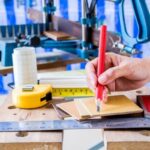When it comes to making improvements to your home, you may find yourself facing a dilemma – the lack of equity. Home improvement loans are an excellent way to finance your renovation projects, but what happens if you don’t have any equity in your property? In this article, we will explore the concept of home improvement loans and delve into the possibilities of getting one without any equity.
Before we dive into the details, let’s first understand the importance of home equity when it comes to loan approvals. Home equity refers to the value of your property that is above and beyond any mortgage or liens against it. It acts as a form of collateral for lenders and provides them with security in case borrowers default on their loan payments. Therefore, having equity is typically a prerequisite for many traditional lending institutions when granting home improvement loans.
However, there are situations where individuals may lack equity in their homes. This can be due to various reasons such as recent purchase, depreciation in property value, or financial constraints. In such cases, it becomes crucial to explore alternative financing options for home improvements. Fortunately, there are viable solutions available even when you have no equity in your property.
In the following sections, we will discuss different ways to obtain a home improvement loan without any equity. We will examine options like unsecured personal loans and government programs/grants that offer assistance for projects without equity. Additionally, we’ll provide tips and strategies to improve your chances of securing a loan while lacking equity in order to help you embark on your dream home improvement project.
What is Home Equity and Why is it Important for Loan Approvals?
Home equity is the difference between the current market value of your home and the outstanding balance on your mortgage. It is an important factor for loan approvals because it serves as collateral for lenders. When homeowners have built up significant equity in their homes, lenders are more willing to provide loans because they have a valuable asset that can be used to recover their money if the borrower defaults on payments.
Lenders typically use loan-to-value (LTV) ratio to determine home equity and assess the risk associated with lending. LTV ratio is calculated by dividing the amount borrowed by the appraised value of the property. For example, if you want to borrow $50,000 for home improvements and your home is appraised at $200,000, your LTV ratio would be 25%. Generally, lenders prefer borrowers to have an LTV ratio below 80% as it indicates a lower risk of default.
Having a higher amount of equity in your home also gives you access to larger loan amounts and better interest rates. This is because lenders consider homeowners with higher equity as being less likely to default on their loans, making them more favorable borrowers. On the other hand, homeowners with little or no equity may find it challenging to secure a home improvement loan as they are seen as higher risk borrowers.
It’s important to note that when applying for a home improvement loan without equity, borrowers often face stricter requirements and higher interest rates compared to those with substantial equity. This is why it’s crucial for homeowners lacking equity to explore alternative financing options that may be available to them.
Exploring the Need for Home Improvement Loans
Home improvement projects are often necessary to maintain and upgrade a property, but they can come with a significant cost. Many homeowners turn to home improvement loans as a means to finance these projects, but what happens when you don’t have enough equity in your home? In this section, we will explore the need for home improvement loans and why some individuals may lack equity.
Equity is essentially the difference between the market value of your home and the amount you owe on your mortgage. It represents the portion of your property that you truly own. When it comes to getting approved for a home improvement loan, equity plays a crucial role. Lenders typically require borrowers to have a certain amount of equity in their homes in order to secure a loan.
There are several reasons why some individuals may lack sufficient equity in their homes. One common reason is that they have recently purchased their property and have not yet had time to build up substantial equity.
Additionally, homeowners who have experienced declining property values or owe more on their mortgage than their home is worth may find themselves with limited or no equity. Another scenario is when homeowners have low initial down payments or have refinanced multiple times, which can diminish their equity position.
Despite lacking sufficient equity, homeowners still need financial assistance for their home improvement projects. In the following sections, we will explore various options available for those with limited or no equity such as unsecured personal loans and government programs and grants designed specifically to assist homeowners in financing their renovations without relying on traditional home equity requirements.
Can I Get a Home Improvement Loan With No Equity? Exploring the Possibilities
When it comes to home improvement projects, many individuals find themselves in a situation where they may lack the necessary equity to secure a traditional home improvement loan. However, that doesn’t mean there are no options available for obtaining financing. In this section, we will explore the possibilities for getting a home improvement loan with no equity.
One alternative financing option for individuals without equity is through unsecured personal loans. These types of loans do not require borrowers to have collateral such as home equity. Instead, lenders assess the borrower’s creditworthiness and income stability when determining eligibility for these loans. Unsecured personal loans can be an attractive option for those looking to make smaller-scale improvements or repairs without putting their home at risk.
Another avenue worth considering is government programs and grants specifically designed to assist homeowners with limited or no equity in their homes. Some government programs offer low-interest or forgivable loans to help individuals fund their home improvement projects. Additionally, there are various grants available that can provide funding based on specific criteria such as income level or geographic location. These types of programs and grants can help homeowners finance renovations or upgrades without relying on equity as collateral.
In order to improve your chances of securing a home improvement loan with no equity, there are several tips and strategies you can employ. First, improving your credit score is crucial as it demonstrates financial responsibility and makes you more appealing as a borrower.
Paying off any existing debts or reducing your debt-to-income ratio can also strengthen your financial profile. Additionally, providing detailed plans and cost estimates for your intended project can give lenders confidence in lending you the necessary funds.
Overall, while lacking equity may present some challenges in obtaining a home improvement loan, there are still viable options available. Whether it’s through unsecured personal loans, government programs and grants, or implementing smart strategies to improve your chances, it is possible to finance your dream home improvement project even without equity. By exploring the possibilities and evaluating the available options, you can chart a path towards achieving your desired upgrades or renovations.
Alternative Financing Options for Home Improvements When Equity is Limited or Non-existent
For homeowners who do not have sufficient equity in their homes, securing a traditional home improvement loan may seem like an impossible task. However, there are alternative financing options available that can help fund your home improvement projects even when equity is limited or non-existent.
One option to consider is an unsecured personal loan. Unlike home equity loans or lines of credit where your home acts as collateral, unsecured personal loans do not require any collateral.
Instead, lenders approve these loans based on factors such as credit history, income, and debt-to-income ratio. Interest rates for unsecured personal loans may be higher than those for home equity loans, but they can still be a viable option if you need funds for smaller home improvement projects.
Another alternative financing option to explore is government programs and grants. Many local and national government agencies offer assistance to homeowners looking to make improvements to their homes. These programs and grants are typically targeted towards low-income individuals or those in certain geographical areas. Qualifications and requirements vary depending on the program, so it’s important to research and find out which ones you may be eligible for.
To increase your chances of securing a home improvement loan with no equity, there are several tips and strategies you can employ. First, work on improving your credit score by paying off debts and making timely payments on existing loans. This will show lenders that you are financially responsible and can manage new debt. Additionally, consider exploring different lenders including credit unions or online lenders that may have more flexible lending criteria compared to traditional banks.
In summary, while having no equity in your home may limit some of your options for financing home improvements, there are still viable alternatives available. From unsecured personal loans to government programs and grants, homeowners have various avenues to explore when seeking funding for their home improvement projects. By understanding the different options available and implementing strategies to improve your chances of loan approval, you can still make your dream home improvements a reality.
| Alternative Financing Option | Description |
|---|---|
| Unsecured Personal Loans | Lenders approve these loans based on factors such as credit history, income, and debt-to-income ratio. No collateral is required. |
| Government Programs and Grants | Local and national government agencies offer assistance to homeowners looking to make improvements to their homes. Qualifications and requirements vary depending on the program. |
| Tips and Strategies for Loan Approval | Improve credit score, consider different lenders, and explore flexible lending criteria offered by credit unions or online lenders. |
Unsecured Personal Loans
Unsecured personal loans can be a viable option for individuals who are looking to finance their home improvement projects but do not have any equity in their homes. These types of loans are not tied to any collateral, such as the value of your home, making them accessible to borrowers who may not have built up significant equity yet.
What are unsecured personal loans?
Unsecured personal loans, as the name suggests, are loans that are not backed by any form of collateral. This means that lenders rely solely on the borrower’s creditworthiness and ability to repay the loan. Unlike traditional home improvement loans where the equity in a property serves as security, unsecured personal loans pose less risk for borrowers as they don’t risk losing their homes in case of default.
The benefits and drawbacks
One of the key benefits of unsecured personal loans is that they provide flexibility and convenience. Since there is no need for an appraisal or evaluation of home equity, the approval process is often quicker than with traditional secured loans. Additionally, borrowers can use the funds from an unsecured personal loan for a variety of purposes beyond just home improvement projects.
However, it’s important to consider some drawbacks as well. Unsecured personal loans tend to have higher interest rates compared to secured home improvement loans due to the increased risks for lenders. Additionally, because these loans are based primarily on creditworthiness, borrowers with lower credit scores may find it more difficult to qualify or may face higher interest rates.
Alternative financing options
While unsecured personal loans offer a viable option for those without equity who want to undertake home improvement projects, there may be other alternative financing options available as well. These could include government programs and grants specifically designed to assist homeowners with limited or no equity in improving their properties.
It’s worth exploring these alternatives before settling on a specific loan option, as they may offer more favorable terms or financial assistance that can help make your dream home improvement project a reality.
Government Programs and Grants
When homeowners find themselves in need of home improvement loans but lacking equity, government programs and grants can provide valuable assistance. These programs are designed to support individuals who may not have enough equity in their homes to qualify for traditional home improvement loans. By exploring these options, homeowners can find opportunities to finance their projects and make necessary upgrades to their properties.
One option that homeowners may consider is the Federal Housing Administration’s Title I Property Improvement Loan program. This program allows borrowers to obtain loans up to $25,000 for home improvements without requiring any equity.
The loans are insured by the FHA, which means that borrowers with lower credit scores or limited equity may still qualify. These loans can be used for a variety of improvements, such as repairing or replacing heating systems, installing energy-efficient windows, or making accessibility modifications.
Another government assistance option is the Department of Agriculture’s Single Family Housing Repair Loans & Grants program. This program provides grants and low-interest loans to eligible homeowners in rural areas who need financial assistance for home repairs or improvements. The grants are specifically designed for individuals aged 62 and older who cannot repay a loan but need funds for necessary repairs or modifications.
In addition to federal government programs, there may also be state-specific programs and grants available to homeowners without equity. Many states offer various financial aid options targeted at specific needs or demographics, such as energy-efficient upgrades or assistance for low-income households.
It is crucial for homeowners seeking assistance through government programs and grants to thoroughly research and understand the eligibility requirements and application processes. Each program may have different criteria and limitations, so it is essential to gather all the necessary documentation and information before applying. Additionally, applicants should be prepared for potentially lengthy approval processes as these programs often receive high volumes of requests.
Tips and Strategies to Improve Chances of Securing a Home Improvement Loan with No Equity
Improve Your Credit Score
One of the most important factors that lenders consider when offering home improvement loans without equity is your credit score. A higher credit score demonstrates financial responsibility and increases your chances of getting approved for a loan. If you have a low credit score, there are several steps you can take to improve it.
Start by making payments on time and reducing your debt-to-income ratio. Additionally, check your credit report for any errors or inaccuracies that may be bringing down your score, and dispute them if necessary.
Provide Detailed Project Plans and Estimates
When applying for a home improvement loan with no equity, it’s crucial to provide detailed project plans and estimates to lenders. This helps them understand how the funds will be used and increases their confidence in approving your loan request. Include information such as the scope of work, materials needed, contractor quotes, and timelines for completion. The more specific you can be about your project, the better chance you have of securing a loan.
Demonstrate Stable Income
Lenders want to ensure that you have a reliable source of income to repay the loan, especially if you do not have any equity in your home. Provide evidence of stable employment or consistent self-employment income through pay stubs, tax returns, and bank statements. If you receive other forms of income such as rental revenue or investments, include documentation for those as well. Demonstrating a steady income stream will increase lenders’ confidence in your ability to repay the loan.
Explore Co-Signers or Joint Applications
If you are unable to secure a home improvement loan with no equity on your own, consider exploring co-signers or joint applications with someone who has better financial standing or equity in their property. A co-signer with strong credit and substantial equity can increase your chances of approval. However, keep in mind that co-signing or taking on a joint application means both parties are equally responsible for repaying the loan.
By following these tips and strategies, you can improve your chances of securing a home improvement loan without equity. Remember to research and compare different lenders to find the best terms and rates for your needs. With careful preparation and documentation, you can make your dream home improvement project a reality, even without equity in your home.
Essential Factors Lenders Consider When Offering Home Improvement Loans without Equity
When lenders consider offering home improvement loans without equity, there are several essential factors that they take into consideration. These factors help determine the viability of the loan and whether or not the borrower is a reliable candidate for funding. By understanding these factors, potential borrowers can better prepare themselves and improve their chances of securing a home improvement loan.
One of the key factors that lenders consider is the borrower’s credit score. A higher credit score indicates a history of responsible financial management and increases the likelihood of loan approval. Lenders typically prefer borrowers with credit scores above 650, although some may consider lower scores as well. Borrowers with lower credit scores should be prepared to provide additional documentation, such as proof of income or assets, to support their loan application.
Another important factor lenders take into account is the borrower’s income and employment history. Lenders want assurance that borrowers have a stable source of income to cover monthly payments on the home improvement loan. They often require documentation such as pay stubs or tax returns to verify income and employment status. Borrowers who are self-employed may need to provide additional documentation, such as business profit and loss statements, to demonstrate their financial stability.
Additionally, lenders assess a borrower’s debt-to-income ratio (DTI) when considering home improvement loans without equity. DTI compares an individual’s monthly debt payments to their gross monthly income. A lower DTI suggests that a borrower has enough income available to comfortably manage additional debt from a home improvement loan. Most lenders prefer a DTI below 43%, although some may accept slightly higher ratios depending on other factors such as credit score.
By effectively addressing these essential factors, potential borrowers can increase their chances of obtaining a home improvement loan without equity. Maintaining good credit, demonstrating stable income and employment, and managing debt responsibly are all crucial in convincing lenders to approve the loan application.
Additionally, borrowers should be prepared with supporting documents and be proactive in providing any necessary information to the lender. With careful preparation and a thorough understanding of these factors, borrowers can navigate the process more confidently and secure the financing they need for their home improvement project.
Conclusion
In conclusion, while it may seem challenging to obtain a home improvement loan without equity, there are indeed options available for individuals in this situation. The key is to evaluate the available options and choose the one that best suits your needs and financial situation.
One alternative financing option for home improvements when equity is limited or non-existent is unsecured personal loans. These loans do not require any collateral, such as home equity, and can be used for various purposes, including home improvements. However, it’s important to keep in mind that these loans often come with higher interest rates and shorter repayment terms compared to traditional home equity loans.
Another avenue worth exploring is government programs and grants that provide assistance for home improvement projects without equity. These programs are designed to help individuals with limited resources make necessary upgrades to their homes. It’s important to research and understand the eligibility criteria and application process for these programs.
To improve your chances of securing a home improvement loan with no equity, there are several tips and strategies you can employ. First, work on improving your credit score by making timely payments on existing debts and reducing credit card balances.
Lenders often consider creditworthiness when evaluating loan applications. Additionally, presenting a detailed plan of your intended home improvement project along with estimates from contractors can show lenders that you have carefully thought through the project and have a solid plan in place.
Frequently Asked Questions
What disqualifies you from getting a home equity loan?
There are several factors that can disqualify an individual from getting a home equity loan. Firstly, a low credit score can be a major disqualification as it indicates a higher level of risk for the lender. Additionally, insufficient income or unstable employment history can also hinder one’s ability to qualify for this type of loan.
If there is already an existing mortgage on the property and it exceeds certain loan-to-value ratios set by lenders, it may disqualify an individual from obtaining a home equity loan. Lastly, if the property itself has significant liens or judgments against it, lenders may consider this as disqualifying since those claims supersede the borrower’s interest.
Do you have to have equity to get a home equity loan?
Yes, having equity in a property is generally a requirement to qualify for a home equity loan. A home equity loan is essentially borrowing against the value of one’s property that exceeds any outstanding mortgages or liens.
This excess value is known as home equity and serves as collateral for the loan. Lenders typically have specific requirements regarding how much equity needs to be present in order to qualify for a home equity loan, often requiring borrowers to have at least 15-20% equity in their homes.
How to get a loan for an addition without equity?
Obtaining a loan for an addition without having existing home equity can be challenging but not impossible. In such cases, alternative financing options need to be explored. One possible option could be taking out a personal loan based on one’s creditworthiness and income stability.
Personal loans generally do not require collateral like home equity loans do, but they may come with higher interest rates and shorter repayment terms. Another option could be exploring government-sponsored programs that assist homeowners with financing home improvements or additions, which may have less strict requirements regarding existing equity but might involve certain income limits or qualifications. It may also be worth considering other financing avenues such as savings or borrowing from family or friends if feasible.

I’m thrilled to have you here as a part of the Remodeling Top community. This is where my journey as an architect and remodeling enthusiast intersects with your passion for transforming houses into dream homes.





